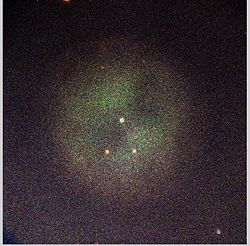
Owl Nebula
Encyclopedia
The Owl Nebula is a planetary nebula
in the constellation
Ursa Major
. It was discovered by Pierre Méchain
in 1781.
M97 is regarded as one of the more complex of the planetaries. The 16th magnitude
central star
has about 0.7 solar mass
and the nebula itself about 0.15 solar mass. The nebula formed roughly 6,000 years ago.
The nebula gets it name due to the appearance of owl-like "eyes" when view through a large (>200 mm) telescope under dark sky conditions with the aid of a so-called "nebula filter." The "eyes" are also easily visible through photographs taken of the nebula.

Planetary nebula
A planetary nebula is an emission nebula consisting of an expanding glowing shell of ionized gas ejected during the asymptotic giant branch phase of certain types of stars late in their life...
in the constellation
Constellation
In modern astronomy, a constellation is an internationally defined area of the celestial sphere. These areas are grouped around asterisms, patterns formed by prominent stars within apparent proximity to one another on Earth's night sky....
Ursa Major
Ursa Major
Ursa Major , also known as the Great Bear, is a constellation visible throughout the year in most of the northern hemisphere. It can best be seen in April...
. It was discovered by Pierre Méchain
Pierre Méchain
Pierre François André Méchain was a French astronomer and surveyor who, with Charles Messier, was a major contributor to the early study of deep sky objects and comets.-Life:...
in 1781.
M97 is regarded as one of the more complex of the planetaries. The 16th magnitude
Apparent magnitude
The apparent magnitude of a celestial body is a measure of its brightness as seen by an observer on Earth, adjusted to the value it would have in the absence of the atmosphere...
central star
Star
A star is a massive, luminous sphere of plasma held together by gravity. At the end of its lifetime, a star can also contain a proportion of degenerate matter. The nearest star to Earth is the Sun, which is the source of most of the energy on Earth...
has about 0.7 solar mass
Solar mass
The solar mass , , is a standard unit of mass in astronomy, used to indicate the masses of other stars and galaxies...
and the nebula itself about 0.15 solar mass. The nebula formed roughly 6,000 years ago.
The nebula gets it name due to the appearance of owl-like "eyes" when view through a large (>200 mm) telescope under dark sky conditions with the aid of a so-called "nebula filter." The "eyes" are also easily visible through photographs taken of the nebula.

See also
- Messier objectMessier objectThe Messier objects are a set of astronomical objects first listed by French astronomer Charles Messier in 1771. The original motivation of the catalogue was that Messier was a comet hunter, and was frustrated by objects which resembled but were not comets...
- List of Messier objects
- New General CatalogueNew General CatalogueThe New General Catalogue of Nebulae and Clusters of Stars is a well-known catalogue of deep sky objects in astronomy. It contains 7,840 objects, known as the NGC objects...
- List of planetary nebulas

